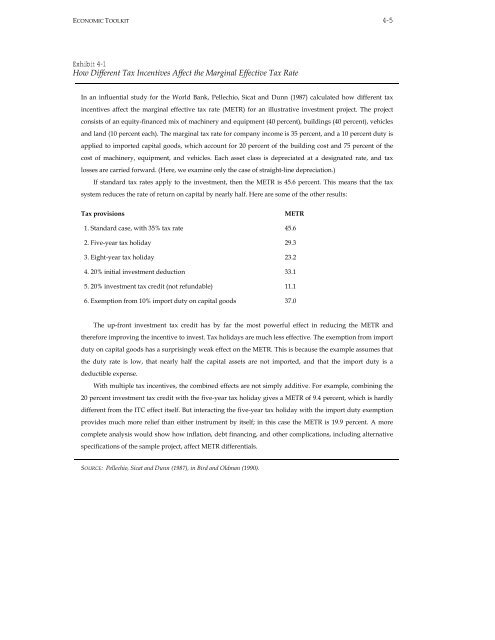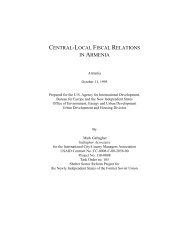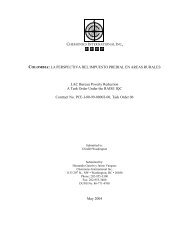Effectiveness and Economic Impact of Tax Incentives in the SADC ...
Effectiveness and Economic Impact of Tax Incentives in the SADC ...
Effectiveness and Economic Impact of Tax Incentives in the SADC ...
You also want an ePaper? Increase the reach of your titles
YUMPU automatically turns print PDFs into web optimized ePapers that Google loves.
ECONOMIC TOOLKIT 4-5<br />
Exhibit 4-1<br />
How Different <strong>Tax</strong> <strong>Incentives</strong> Affect <strong>the</strong> Marg<strong>in</strong>al Effective <strong>Tax</strong> Rate<br />
In an <strong>in</strong>fluential study for <strong>the</strong> World Bank, Pellechio, Sicat <strong>and</strong> Dunn (1987) calculated how different tax<br />
<strong>in</strong>centives affect <strong>the</strong> marg<strong>in</strong>al effective tax rate (METR) for an illustrative <strong>in</strong>vestment project. The project<br />
consists <strong>of</strong> an equity-f<strong>in</strong>anced mix <strong>of</strong> mach<strong>in</strong>ery <strong>and</strong> equipment (40 percent), build<strong>in</strong>gs (40 percent), vehicles<br />
<strong>and</strong> l<strong>and</strong> (10 percent each). The marg<strong>in</strong>al tax rate for company <strong>in</strong>come is 35 percent, <strong>and</strong> a 10 percent duty is<br />
applied to imported capital goods, which account for 20 percent <strong>of</strong> <strong>the</strong> build<strong>in</strong>g cost <strong>and</strong> 75 percent <strong>of</strong> <strong>the</strong><br />
cost <strong>of</strong> mach<strong>in</strong>ery, equipment, <strong>and</strong> vehicles. Each asset class is depreciated at a designated rate, <strong>and</strong> tax<br />
losses are carried forward. (Here, we exam<strong>in</strong>e only <strong>the</strong> case <strong>of</strong> straight-l<strong>in</strong>e depreciation.)<br />
If st<strong>and</strong>ard tax rates apply to <strong>the</strong> <strong>in</strong>vestment, <strong>the</strong>n <strong>the</strong> METR is 45.6 percent. This means that <strong>the</strong> tax<br />
system reduces <strong>the</strong> rate <strong>of</strong> return on capital by nearly half. Here are some <strong>of</strong> <strong>the</strong> o<strong>the</strong>r results:<br />
<strong>Tax</strong> provisions METR<br />
1. St<strong>and</strong>ard case, with 35% tax rate 45.6<br />
2. Five-year tax holiday 29.3<br />
3. Eight-year tax holiday 23.2<br />
4. 20% <strong>in</strong>itial <strong>in</strong>vestment deduction 33.1<br />
5. 20% <strong>in</strong>vestment tax credit (not refundable) 11.1<br />
6. Exemption from 10% import duty on capital goods 37.0<br />
The up-front <strong>in</strong>vestment tax credit has by far <strong>the</strong> most powerful effect <strong>in</strong> reduc<strong>in</strong>g <strong>the</strong> METR <strong>and</strong><br />
<strong>the</strong>refore improv<strong>in</strong>g <strong>the</strong> <strong>in</strong>centive to <strong>in</strong>vest. <strong>Tax</strong> holidays are much less effective. The exemption from import<br />
duty on capital goods has a surpris<strong>in</strong>gly weak effect on <strong>the</strong> METR. This is because <strong>the</strong> example assumes that<br />
<strong>the</strong> duty rate is low, that nearly half <strong>the</strong> capital assets are not imported, <strong>and</strong> that <strong>the</strong> import duty is a<br />
deductible expense.<br />
With multiple tax <strong>in</strong>centives, <strong>the</strong> comb<strong>in</strong>ed effects are not simply additive. For example, comb<strong>in</strong><strong>in</strong>g <strong>the</strong><br />
20 percent <strong>in</strong>vestment tax credit with <strong>the</strong> five-year tax holiday gives a METR <strong>of</strong> 9.4 percent, which is hardly<br />
different from <strong>the</strong> ITC effect itself. But <strong>in</strong>teract<strong>in</strong>g <strong>the</strong> five-year tax holiday with <strong>the</strong> import duty exemption<br />
provides much more relief than ei<strong>the</strong>r <strong>in</strong>strument by itself; <strong>in</strong> this case <strong>the</strong> METR is 19.9 percent. A more<br />
complete analysis would show how <strong>in</strong>flation, debt f<strong>in</strong>anc<strong>in</strong>g, <strong>and</strong> o<strong>the</strong>r complications, <strong>in</strong>clud<strong>in</strong>g alternative<br />
specifications <strong>of</strong> <strong>the</strong> sample project, affect METR differentials.<br />
SOURCE: Pellechio, Sicat <strong>and</strong> Dunn (1987), <strong>in</strong> Bird <strong>and</strong> Oldman (1990).











